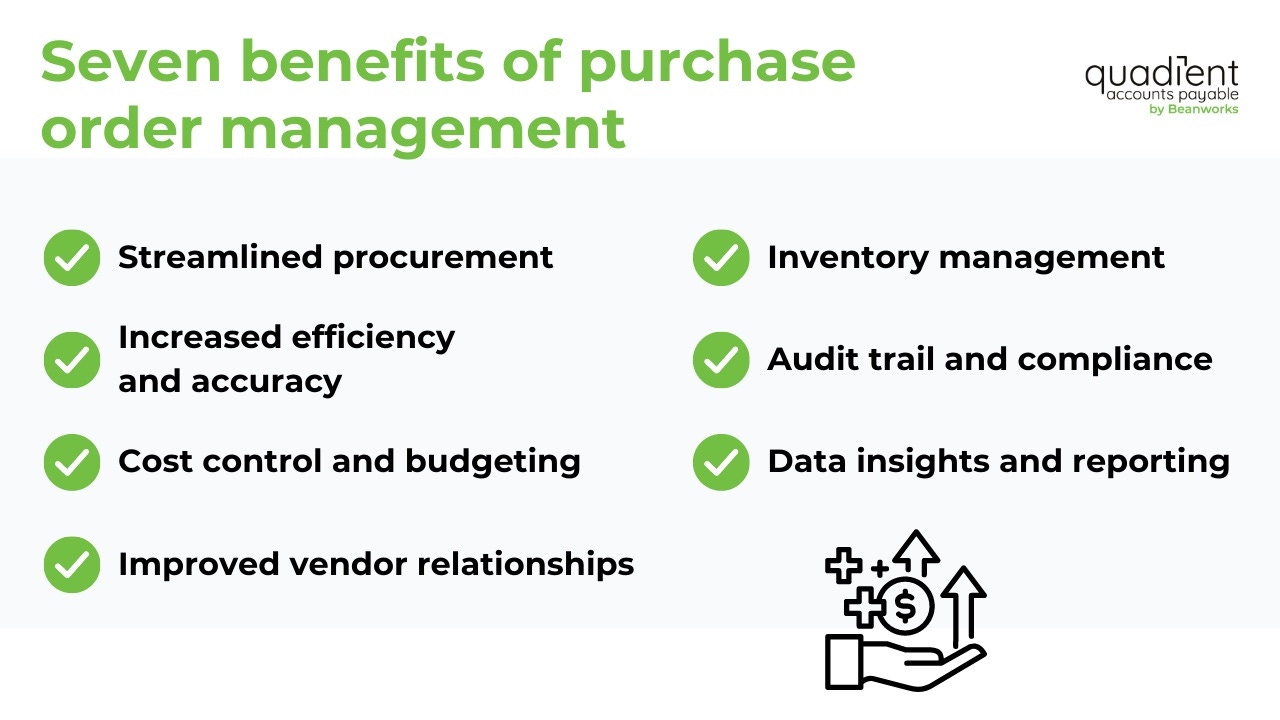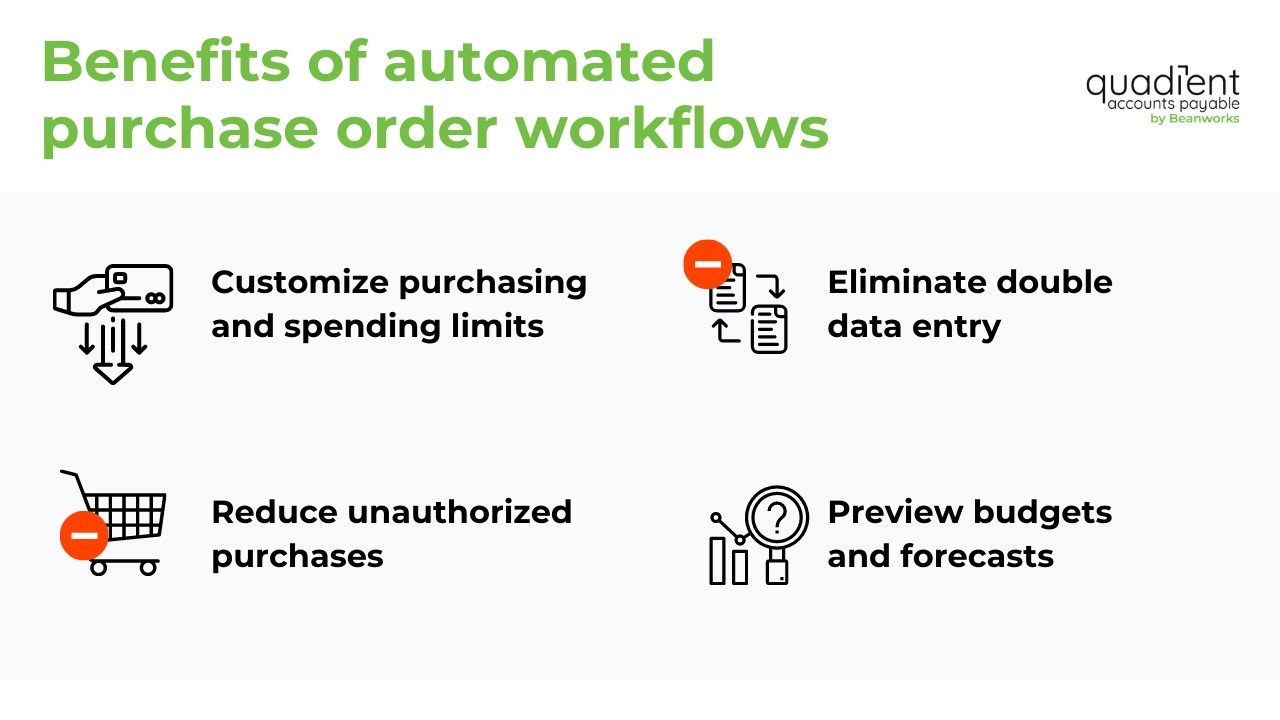Introduction
The efficient management of purchase orders (POs) is critical to successful business operations. PO management offers a structured approach to handling procurement, ensuring smooth transactions, enhanced control, and improved vendor relationships.
This article delves into PO management – what it is and why it’s important. We’ll highlight the benefits it brings to organizations. We’ll explore the purchase requisition process and discuss manual vs. automated PO workflows and the benefits of automated PO workflows. With an effective purchase order management system, businesses can optimize their purchasing operations and achieve greater operational efficiency.
What is purchase order management, and why is it important?
Purchase order management refers to the process of creating, tracking, and managing purchase orders in a business.
The efficient and effective management of purchase orders is important because it streamlines the procurement process. It reduces errors, improves transparency, and ensures compliance with organizational policies and budgets. In addition, it facilitates better inventory management, financial planning, and vendor relationship management.
Seven benefits of purchase order management
Effective purchase order management offers several benefits for businesses:

- Streamlined procurement: PO management provides a structured and systematic approach to the procurement process. It ensures that all purchases go through an organized workflow, from requisition to approval, ordering, and receiving. This helps businesses maintain consistency and efficiency in their procurement operations.
- Increased efficiency and accuracy: Businesses can reduce manual errors and improve accuracy by automating the PO process. Purchase order management software automatically populates vendor information, item details, quantities, and prices, significantly minimizing data entry mistakes. It enables quick and accurate order processing, eliminates delays, and reduces the likelihood of incorrect shipments.
- Cost control and budgeting: An effective PO management process gives businesses control over their spending. It enables organizations to set budgets, enforce spending limits, and track expenses against those budgets. A clear view of committed and planned purchases enables businesses to make informed decisions and avoid overspending.
- Improved vendor relationships: PO management facilitates better communication and collaboration with vendors. It provides a standardized way of communicating requirements, specifications, and delivery details. This reduces misunderstandings and disputes. Timely and accurate POs help build trust with suppliers, resulting in stronger and more reliable vendor relationships.
- Inventory management: Integrating PO management with inventory systems allows businesses to maintain optimal stock levels. By tracking incoming orders, businesses can better manage inventory replenishment and avoid stockouts or excess inventory. This ensures minimizes carrying costs and improves overall inventory management.
- Audit trail and compliance: Purchase order software systems generate a comprehensive audit trail, documenting the entire purchasing process. This is valuable for internal control, accountability, and compliance purposes. It helps businesses adhere to financial regulations, internal policies, and audit requirements, ensuring transparency and accountability in procurement activities.
- Data insights and reporting: PO management systems capture valuable data on purchasing trends, vendor performance, and expenditure patterns. By analyzing this data, businesses can identify cost-saving opportunities, negotiate better contracts, and optimize their procurement strategies. Comprehensive reporting capabilities provide valuable insights for decision-making and strategic planning.
These benefits contribute to cost savings and better overall business performance.
The purchase requisition process
What is a purchase requisition?
A purchase requisition, or purchase order request, is a formal document used to initiate the process of procuring goods or services. It’s a request made by an employee or department to buy goods or services required for business operations.
Purchase requisitions contain essential details such as the description of the requested items, quantity, estimated budget, and any other relevant specifications.
How does a purchase requisition work?
The purchase requisition process begins when an employee identifies a need for certain products or services. They fill out a purchase requisition form, either in a physical or digital format, providing the necessary details. This form is then submitted to the designated authority for review and approval. The approving authority verifies the request, ensuring that it aligns with the organization's budget and procurement policies.
Upon approval, the purchase requisition is forwarded to the procurement team. The procurement team reviews the requisition and verifies the availability of funds. Then it identifies suppliers or vendors who can fulfill the request. The procurement team may compare prices, negotiate contracts, and evaluate the options prior to selecting the most suitable vendor.
The procurement team then creates a PO based on the approved requisition. A PO is an agreement between the organization and the vendor that specifies the details of the purchase. The PO is then sent to the vendor, who acknowledges the order and proceeds to fulfill the request.
Examples of a purchase requisition process
The purchase requisition process varies depending on the organization and industry. In a manufacturing company, for instance, a production manager might submit a requisition for raw materials needed for the production line. In an IT department, an employee might submit a requisition for new software licenses or computer equipment.
Regardless of the specific context, the purchase requisition process ensures a systematic and controlled approach to acquiring goods and services. It promotes transparency, budget adherence, and efficient procurement practices within an organization.
Manual vs. automated purchase order workflows
POs are designed to bring structure and clarity to the procurement process. They provide a system to record and approve requested resources. However, the lack of a structured workflow can cause friction, be manually intensive, and encourage employees to take risky shortcuts. Lack of end-to-end visibility can result in unknown expenses or the status of individual POs.
The first step in establishing an optimized PO workflow is to implement a formal requisition process. By utilizing PO forms, every purchase is documented and monitored, facilitating the easy matching of invoices to POs. This aids in monitoring approved spending and verifying that the received goods align with the ordered items.
Another effective practice is to create an approval network for managing departmental expenditures. Clearly assigning responsibility for purchase requests between employees and approvers fosters a culture of accountability.
Benefits of automated purchase order workflows
Automation is key to fully maximizing the benefits of the PO process for your business,
By automating the PO process, you gain the ability to:

- Customize purchasing and spending limits: Businesses can establish a process to manage authorized purchasers and their spending limits. Limits can be set based on department, project, vendor, or manager budgets to prevent unauthorized expenditures.
- Reduce unauthorized purchases: Automated approval and routing help prevent unnoticed fulfillment of POs by the approval manager or AP team.
- Eliminate double data entry: By automatically matching POs to invoices, the need for entering information in multiple systems is eliminated.
- Preview budgets and forecasts: A centralized dashboard provides complete visibility to payments, invoices, and expenses. This allows you to measure how each of them is contributing to your overall growth.
Implementing a smart automation platform saves time, enhances spending tracking with fewer errors, and provides accurate data for better business management.
Conclusion
PO automation enables the streamlined processing of POs. It provides complete visibility into open POs. It reduces errors, enhances efficiency, accelerates the entire process, and ensures proper justification for every purchase.
Automation software, like Quadient AP, allows you to manage not only POs, but also invoices, expenses, and payments. It enables automatic routing and simplifies approvals through the mobile app. It aids in forecasting with a complete view of your spending. It’s time to stop relying on manual purchase order processes and embrace what technology can do for your PO management.







